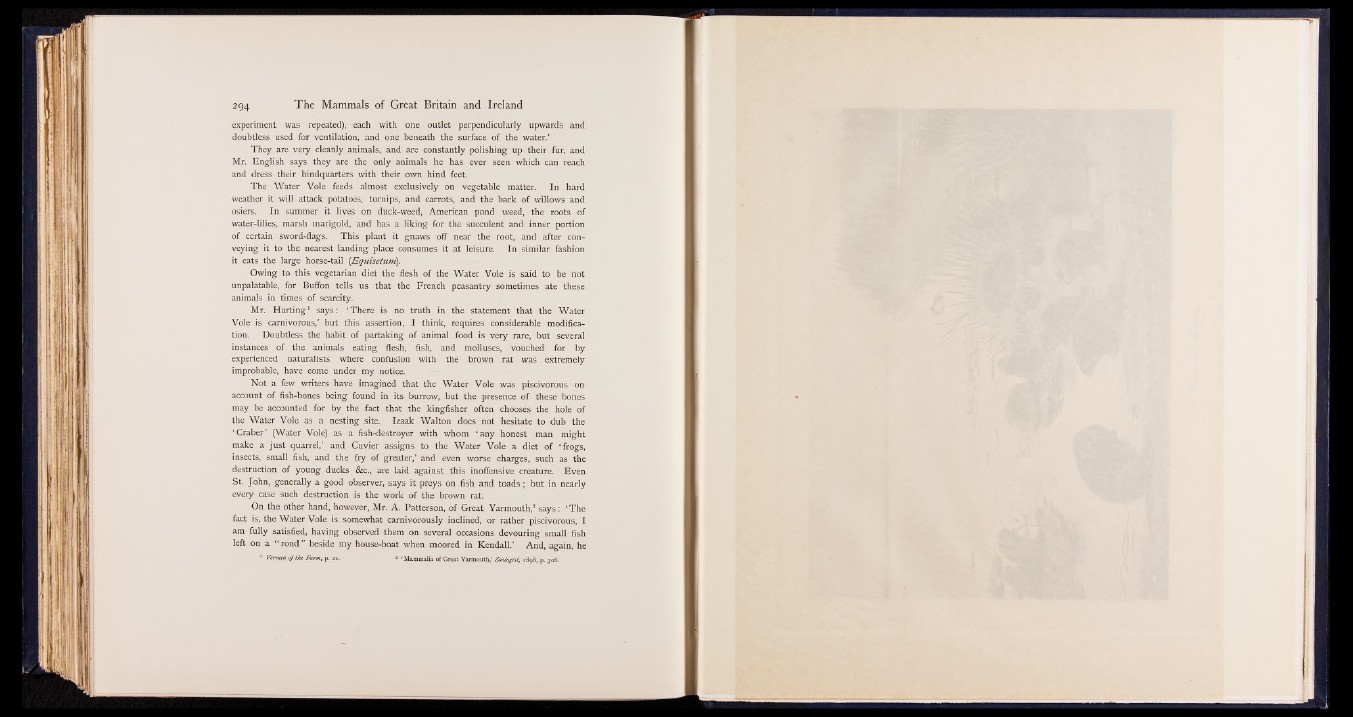
experiment was repeated), each with one outlet perpendicularly upwards and
doubtless used for ventilation, and one beneath the surface of the water.'
They are very cleanly animals, and are constantly polishing up their fur, and
Mr. English says they are the only animals he has ever seen which can reach
and dress their hindquarters with their own hind feet.
The Water Vole feeds almost exclusively on vegetable matter. In hard
weather it will attack potatoes, turnips, and carrots, and the bark of willows and
osiers. In summer it lives on duck-weed, American pond weed, the roots of
water-lilies, marsh marigold, and has a liking for the succulent and inner portion
of certain sword-flags. This plant it gnaws off near the root, and after conveying
it to the nearest landing place consumes it at leisure. In similar fashion
it eats the large horse-tail (Equisetum).
Owing to this vegetarian diet the flesh of the Water Vole is said to be not
unpalatable, for Buffon tells us that the French peasantry sometimes ate these
animals in times of scarcity.
Mr. Halting1 says: ‘ There is no truth in the statement that the Water
Vole is carnivorous,’ but this assertion, I think, requires considerable modification.
Doubtless the habit of partaking of animal food is very rare, but several
instances of the animals eating flesh, fish, and molluscs, vouched for by
experienced naturalists where confusion with the brown rat was extremely
improbable, have come under my notice.
Not a few writers have imagined that the Water Vole was piscivorous on
account of fish-bones being found in its burrow, but the presence of these bones
may be accounted for by the fact that the kingfisher often chooses the hole of
the Water Vole as a nesting site. Izaak Walton does not hesitate to dub the
‘ Craber’ (Water Vole) as a fish-destroyer with whom ‘ any honest man might
make a just quarrel,’ and Cuvier assigns to the Water Vole a diet of ‘ frogs,
insects, small fish, and the fry of greater,’ and even worse charges, such as the
destruction of young ducks &c., are laid against this inoffensive creature. Even
St. John, generally a good observer, says it preys on fish and toads; but in nearly
every case such destruction is the work of the brown rat.
On the other hand, however, Mr. A. Patterson, of Great Yarmouth,2 say s : ‘ The
fact is, the Water Vole is somewhat carnivorously inclined, or rather piscivorous, I
am fully satisfied, having observed them on several occasions devouring small fish
left on a “ rond ” beside my house-boat when moored in Kendall.’ And, again, he
1 Vermin o f the Farm, p. 21. * ‘Mammalia of Great Yarmouth,’ Zoologist, 1898, p. 306.